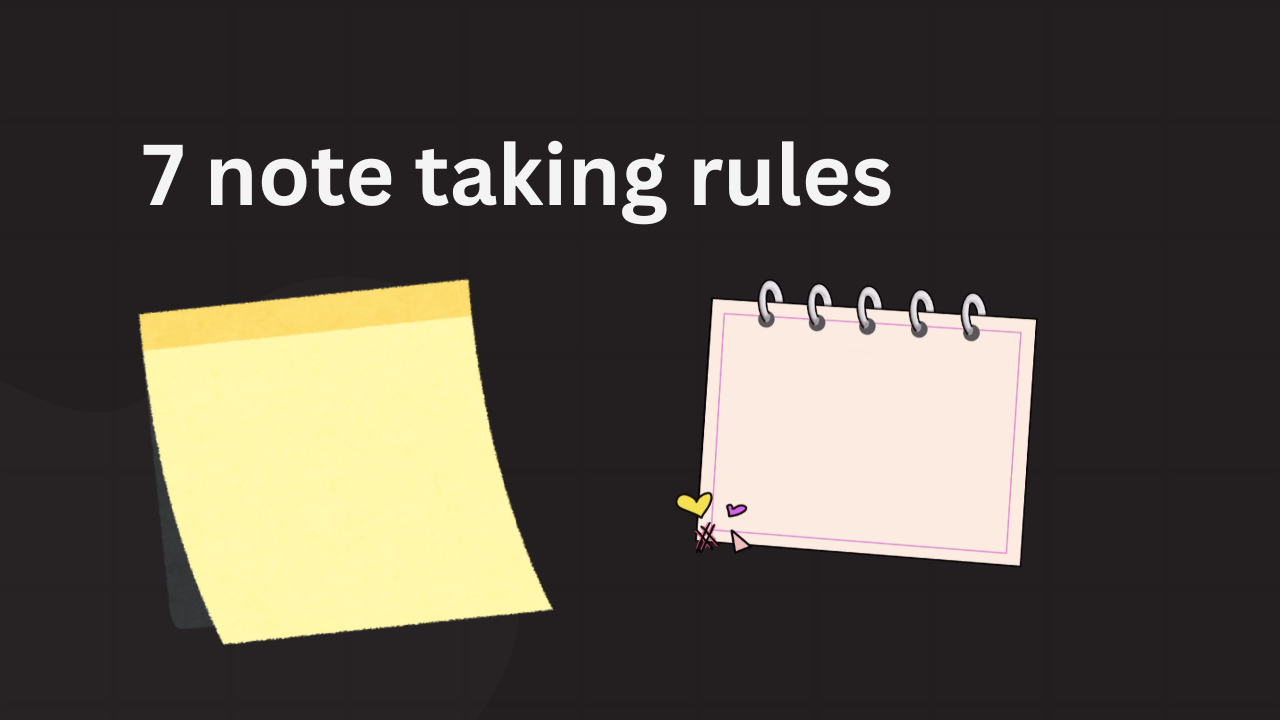Note-taking is not just about jotting down information—it's about capturing value to recall, reflect, and repurpose knowledge effectively. Whether you're a student in a lecture, a professional brainstorming a project, or a content creator distilling insights from a YouTube deep dive, these seven detailed rules will transform you from a passive consumer into an active creator. This guide provides actionable strategies, practical examples, and tool recommendations to make your notes work for you.
1. Write for Your Future Self
Your notes should serve as a bridge to your future self, enabling you to quickly grasp key ideas without wading through irrelevant details. Transcribing verbatim is a trap—it turns you into a typist, not a thinker. Instead, focus on processing information in a way that’s meaningful to you later.
How to Do It:
- Rephrase in Your Own Words: Translate concepts into your unique voice to enhance understanding and retention.
- Add Context: Note why an idea resonated with you or how it applies to your goals. For example, include a parenthetical note like (This could improve my weekly vlog workflow).
- Pose Questions: Jot down unresolved questions to guide future exploration or research.
- Use Visual Cues: Highlight, bold, or use emojis to emphasize key points for quick scanning.
Example Comparison:
Bad Example (Verbatim Transcription):
Systems are better than goals. You don’t rise to the level of your goals, you fall to the level of your systems. Goals are about what you want to achieve, systems are about the processes you follow to get there. For example, if you want to write a book, your goal is the book, but your system is writing every day, editing weekly, and getting feedback. — James Clear, Atomic Habits
Better Example (Personalized Note):
Systems > goals for consistent progress.
- Goals = what I want (e.g., publish 10 YouTube videos this month).
- Systems = how I get there (e.g., film 20 min 3x/week, edit Sundays, get feedback from my Discord group).
- Why this matters: I keep setting big goals but burn out without a plan. Systems feel more sustainable.
- Question: How do I track system adherence? Maybe a habit tracker in Notion?
Pro Tip:
When taking notes, imagine explaining the concept to a friend six months from now. What would you need to include to make it clear and actionable?
2. Use Structure to Clarify Thinking
Disorganized notes lead to disorganized thoughts. A clear structure makes it easier to scan, review, and apply your notes later. Choose a method that aligns with your thinking style and the content you’re capturing.
Popular Note-Taking Structures:
- Cornell Method:
- Left Column: Keywords, questions, or prompts.
- Right Column: Detailed notes, examples, or explanations.
- Bottom Section: A concise summary of the page’s key points.
- Best for: Lectures, webinars, or linear content.
- Boxing Method:
- Group related ideas into distinct “boxes” or sections.
- Use headers or borders to separate topics visually.
- Best for: Brainstorming sessions or multi-topic discussions.
- Mind Mapping:
- Start with a central idea and branch out to related concepts.
- Use lines, colors, or icons to show connections.
- Best for: Visual thinkers or complex, interconnected topics.
- Outline Method:
- Use hierarchical bullet points or numbered lists to organize ideas.
- Indent subpoints to show relationships.
- Best for: Structured content like books or reports.
Example (Cornell Method for a YouTube Video):
Topic: How to Build Habits (Ali Abdaal YouTube Video)
| Cues/Questions | Notes |
|---|---|
| Why systems > goals? | Systems are daily processes (e.g., write 500 words/day) vs. goals (e.g., finish a novel). James Clear says systems build lasting habits. |
| Spaced repetition? | Reviewing notes at intervals (1 day, 1 week, 1 month) boosts retention. |
| Tool suggestion? | TubeMemo: highlight and summarize videos directly. Export to Notion for review. |
Pro Tip:
Experiment with one structure for a week, then adjust based on what feels intuitive. Digital tools like Notion or Obsidian can make structuring notes easier with templates.
3. Summarize Immediately to Retain More
The Ebbinghaus Forgetting Curve shows that we forget 50–80% of new information within 24 hours unless we actively reinforce it. Summarizing right after learning locks in key insights, clarifies your understanding, and creates a compact reference for later.
How to Summarize Effectively:
- Do It Immediately: Write a 2–3 sentence summary right after a lecture, video, or meeting.
- Focus on Core Ideas: Distill the main takeaway and one or two supporting points.
- Identify Gaps: Note what’s unclear to guide further research.
- Use Your Own Words: This forces active processing, not just regurgitation.
Example Summary (Post-Webinar):
Webinar: Productivity Hacks for Content Creators (Ali Abdaal)
Ali emphasizes batching tasks (e.g., filming 3 videos in one day) to save mental energy. Spaced repetition for reviewing notes helps retain insights long-term. TubeMemo’s highlight feature is great for capturing key moments during videos and exporting them to Notion for action items. Unclear: How to balance batching with creative spontaneity?
Pro Tip:
Set a timer for 3 minutes after a learning session to write a quick summary. This small habit can boost retention by up to 10x over passive note-taking.
4. Highlight Actionable Insights
Not all notes are created equal. Some inspire action, others spark ideas, and some are just interesting but not immediately useful. Use tags or symbols to prioritize notes that drive progress.
Suggested Tags:
- 🔥 Actionable Insight: Something you can apply immediately (e.g., a workflow tweak).
- 💡 Idea to Explore: A concept worth researching or brainstorming.
- 🛠️ Task to Implement: A specific action or experiment to test.
Example with Tags:
Video Notes: How to Grow Your YouTube Channel
- “Post consistently, even if it’s just 1 video/week” 🔥
- “Repurpose video content into shorts or blog posts” 💡
- “Test TubeMemo’s export feature to turn highlights into a newsletter” 🛠️
- Question: Can I automate repurposing with Zapier?
Pro Tip:
Review your tagged notes weekly to turn insights into action. For example, move 🛠️ tasks to a to-do list or calendar.
5. Connect Notes to Existing Knowledge
Learning is most effective when you link new information to what you already know. This creates a web of knowledge that’s easier to recall and apply across contexts.
How to Connect Notes:
- Link to Projects: Note how an idea applies to a current or future project.
- Reference Past Notes: Use tools like Obsidian to create hyperlinks between related notes.
- Tie to Questions: Connect new insights to ongoing questions or challenges you’re exploring.
- Use Analogies: Relate new concepts to familiar ones to deepen understanding.
Pro Tip:
Use a tool like Obsidian or Notion to create a “knowledge graph” where notes link to each other, making it easier to spot patterns and connections over time.
6. Review Regularly to Make Notes Stick
Notes are only as valuable as the time you spend revisiting them. Without review, they’re like unopened bookmarks—useless. Regular review reinforces learning, surfaces action items, and inspires new ideas.
Review Strategies:
- Weekly Review (10–15 minutes):
- Re-read your top 3–5 notes from the week.
- Highlight or refine key insights.
- Extract action items or content ideas (e.g., turn a note into a tweet or blog post).
- Spaced Repetition:
- Review notes at increasing intervals (e.g., 1 day, 3 days, 1 week, 1 month).
- Use flashcards or apps like Anki for key concepts.
- Content Creation:
- Turn notes into blog posts, social media threads, or video scripts to reinforce learning.
Pro Tip:
Schedule a recurring calendar event for note review, and use a tool like Notion to tag notes for “Review Later” to streamline the process.
7. Choose Tools That Fit Your Workflow
The best note-taking tool is the one you’ll actually use. Experiment with apps to find what aligns with your needs, whether it’s speed, organization, or integration with other platforms.
Recommended Tools:
- TubeMemo:
- Use Case: Highlight and summarize YouTube videos in real-time.
- Why It’s Great: Exports notes to Notion or other platforms for seamless integration.
- Best for: Content creators and video learners.
- Notion:
- Use Case: Organize notes, create databases, and build systems.
- Why It’s Great: Customizable templates for Cornell, boxing, or outline methods.
- Best for: Project managers and students.
- Obsidian:
- Use Case: Create a knowledge graph with linked notes.
- Why It’s Great: Ideal for long-term knowledge building and cross-referencing.
- Best for: Researchers and writers.
- Apple Notes:
- Use Case: Quick capture of ideas on the go.
- Why It’s Great: Simple, syncs across Apple devices, and supports basic formatting.
- Best for: Casual note-takers.
- Anki:
- Use Case: Spaced repetition for memorizing key concepts.
- Why It’s Great: Flashcards with customizable review schedules.
- Best for: Students and lifelong learners.
Pro Tip:
Start with one tool and master its core features before adding more. Overcomplicating your workflow can kill consistency.
Final Thoughts
Effective note-taking is a superpower for learning, creating, and achieving your goals.
Start small: pick one or two rules to implement this week. Experiment, adjust, and make your notes work for you. Whether you’re studying, creating content, or planning a project, your notes can become a creative engine that drives progress.

